Hi! The Wheel of Time Reread Redux is, once again, a-go-go! Whoo!
Today’s Redux post will cover Chapters 46 and 47 of The Great Hunt, originally reread in this post.
All original posts are listed in The Wheel of Time Reread Index here, and all Redux posts will also be archived there as well. (The Wheel of Time Master Index, as always, is here, which has links to news, reviews, interviews, and all manner of information about the Wheel of Time in general on Tor.com.)
The Wheel of Time Reread is also available as an e-book series! Yay!
All Reread Redux posts will contain spoilers for the entire Wheel of Time series, so if you haven’t read, read at your own risk.
And now, the post!
Chapter 46: To Come Out of the Shadow
“Rand would kill someone who did a thing like that,” Elayne said. She seemed to be steeling herself. “I am sure he would.”
“Perhaps they do,” Nynaeve said, “and perhaps he would. But men often mistake revenge and killing for justice. They seldom have the stomach for justice.”
I am fully aware that the expectation of some folk would be that I would approve of this statement, given that it paints women in a more favorable light than men. That is because of the widely-held assumption that feminism automatically values women over men; that it has decided women are “better” than men and that they therefore deserve more consideration/reward/respect than men do.
The reason for this, of course, is because this is exactly what patriarchy believes, except in reverse. And since feminism is perceived to be patriarchy’s polar opposite, the assumption (or, in many cases, accusation) is that feminism’s aim is to flip the tables entirely, and make men the oppressed gender in return for the oppression they have visited on women. An eye for an eye, so to speak.
But all that means is that a lot of folk still do not understand what feminism is—or, at least, what I understand feminism to be.
I admit it is tempting to believe that Nynaeve’s statement is true, because one is always tempted to root for the home team, so to speak, but it is actually my belief in feminism which prompts me to reject it. Because feminism, as I understand it, is not the belief that women are better than men, but merely the rejection of the idea that men are better than women. Which is not the same thing, believe it or not. True feminism, in my book, seeks not for proof of superiority, but for proof of parity.
Many people believe very strongly that there are fundamental differences between men and women, aside from the obvious physical ones, and maybe there are, but the more I look at it, the more it seems to me that those differences are either unimportant, wholly culturally imposed, or both. In the deepest, most essential ways, I believe, we are all the same—or at least we have all the same potential to be one way or the other.
To me, people are people, in the end, for both good and ill. Desire for revenge is not a gendered trait, any more than the ability to mete out fair justice is the sole province of one sex or the other. I’ve known both women and men who are lousy at being fair, and women and men who are lousy at being unfair. I’ve known women who are willing to go to any lengths to avenge a slight, and men who cannot be roused to retaliation no matter what you do to them. And vice versa.
The capacity for mercy or for vengeance is not a function of what genitalia you have; it is a function of who you are as a person, what your life and experiences and culture and innate intelligence tell you is the right (or wrong) thing to do in a situation.
This is what I believe, anyway. I know there are a lot of people who will disagree, and that’s okay. There are a lot of theories out there, and mine is just one of them. But I do tend to resent it when people assume that because I am a feminist that I must think women should “win” over men. Because that assumption kind of completely misses the point.
I have also tended, perhaps erroneously, perhaps not, to attribute the same reasoning to the gender-based statements the characters of WOT make. Meaning, I tend to believe that when Jordan had Nynaeve say the above statement, for example, he did so to make a gender-flipped point—that in a patriarchal society, that is exactly the sort of seemingly-rational-but-ultimately-nonsensical blanket statement that a man in a position of authority would have said about a woman, and therefore must be viewed as borne more of unconscious prejudice than of any real wisdom. (Pun not intended.)
Which is really rather well demonstrated, I think, by the fact that Egwene (and Elayne) most definitely wanted vengeance over justice here. Whether they were right to want it is beside the point; the point is, Egwene’s actions in this chapter in themselves disprove Nynaeve’s assertion that women are always better suited to dispassionate dispensation of judgment. Because that’s just as much crap as saying that men are the ones better suited to it.
So, sorry, Nynaeve, I love you, but you are wrong on this count. Even if I actually entirely approve of the brand of justice you meted out, I believe it’s because you are awesome, not because women are.
And in just the same way, incidentally, is Egwene’s semi-disastrous decision to take on the Seanchan troops in the street completely a result of what she personally had gone through at their hands. And I still want to be mad at her about it, but really, on reflection it’s sort of difficult for me to be, because, well, I don’t know about anyone else, but in her shoes? I’m not sure I would have done any different. Nynaeve had the luxury of impartiality, in that she hadn’t been tortured and semi-brainwashed for days on end, but Egwene did not. Her actions were still unquestionably foolish, of course, but they’re also pretty understandable, if you ask me.
Ingtar: so it turns out that Ingtar is in pretty rarified company, because with the story finished, I can now state with mostly-confidence that other than Tomas, Verin’s Warder, no other Darkfriend we meet in the series ever truly repents his or her Darkfriendliness the way Ingtar does. And I mean truly repents, on a moral level, not just the “oh shit I’m about to be fed to a Trolloc I NOW SUDDENLY REGRET ALL MY LIFE CHOICES”, wholly selfish kind of repentance we see from random Darkfriends throughout. If I’m wrong about this I’m sure someone will let me know, but even if so it makes Ingtar something of a unicorn.
(Verin doesn’t count on this score, because she was a double agent from the start. Not to mention, from what she told Egwene in TGS, she never had a choice in the matter to begin with. Unless you count “or death” to be a “choice”, which, well, I guess it is one, but Verin’s way was so much awesomer, you guys.)
Anyway. Of course, one must consider the fact that he was right next to three of the strongest ta’veren in forever, but I prefer not to let that tarnish his redemption. I don’t remember if Rand’s benediction for Ingtar got me choked up the first time, or the first Reread time either, but it kind of did this time, a bit. It probably did the other times too, because I am a sucker for a good noble sacrifice.
Speaking of which…
Chapter 47: The Grave Is No Bar to My Call
As is right and proper for an epic fantasy series, the Wheel of Time has quite a few Crowning Moments of Awesome to choose from, and this chapter is most definitely one of them. TGH’s climax is not the best of them (not in my opinion, anyway), but it was definitely the most awesome so far. And this is blissfully true despite the fact that logistically the scene makes no sense at all.
I complained about it in the original commentary, but I really rather understated the case, because trying to summarize this chapter was ridiculous. Condensing action sequences down without making them incomprehensible is always difficult, but when all the participants in it are literally floating around in a both metaphorical and actual fog… well, I remember wanting to bang my head on my keyboard a couple of times during this one. Especially as at the time I was still laboring under the delusion that I should continue to keep the chapter summaries short and sweet. This chapter really should have been my clue that that was just not happening anymore.
You may also note that the original commentary post (and this one too) is headed by the ebook cover art for TGH, by Kekai Kotaki, rather than the dead tree Darrell K. Sweet version. It was not so originally, of course, but once all the ebook covers were released I made the rather whimsical decision to go back and replace the DKS covers with the ebook covers on the posts that covered whatever the ebook art depicted. I’m not sure it worked for all of the books, because I think some things got broken when Tor.com moved to its new infrastructure, but this one carried through just fine, apparently, so that’s nice.
Ironically, though I quite like the ebook cover art for TGH, it’s not actually much more accurate than the DKS version (which I’ll discuss in the next post), since unless I missed something, there were no Trollocs at the battle of Falme. But hey, it still looks pretty cool.
[ETA: As one of my intrepid commenters has pointed out below, the scene depicted in both the ebook cover and on the original DKS cover is not, in fact, the Battle of Falme at all, but the scene much earlier in TGH where Rand recovers the Horn from Fain. Who has, it has been further noted, Trollocs with him. Oops. I’ll leave this ebook cover here as a monument to my own doofiness, but I guess I’m gonna have to change its placement on the original Reread. My bad!]
Anyway, to get back to the chapter itself: it’s kind of difficult at this point to drum up the same sense of wow so cool at the revelations Artur Hawkwing et al dropped in their conversation with Rand, since I am rather more than familiar with them by now, but I still vaguely recall how enthralled I was the first time around and how much more awesome the chapter was back then too as a result.
Also, Hawkwing would totally be the captain of the rugby team, and Lews Therin probably wouldn’t even be all that upset about it.
Hurin: aw, Hurin. We do see you again after this book, it turns out. Sniffle. Though I guess he didn’t get to be a Hero of the Horn after all? Not that we saw, anyway. Oh, well. It was still nice of Hawkwing to say, anyway.
Lastly, I’ll note that my question in the original commentary, about whether Ripped-Out Birgitte would meet Original Recipe Birgitte if the Horn got blown again, was neatly sidestepped in AMOL by having the ripped-out version get killed literally moments before Olver blew the Horn and summoned her and the rest of the Heroes back. Convenient, no? Heh. Also, talk about your short turnover periods.
Although, the lack of a Gaidal Cain (at least as far as I recall) at the Last Battle indicates that even if Birgitte hadn’t died before the Horn was blown, she wouldn’t have met her doppelgänger. Which I suspected in any case, but it was still fun to think about.
But, all quibbles and asides aside, in conclusion: Aw yeah, sweet, sick, killer, dude, awesome, who’s your daddy, bitchin’, Yay.
And that’s our slang for the nonce! Y’all come on back next Tuesday for the conclusion to this particular puppy! Again! Whee!










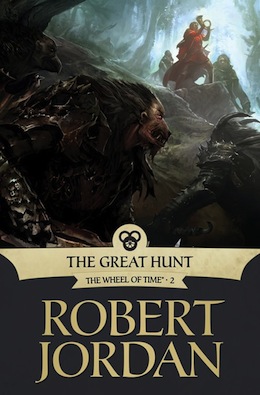
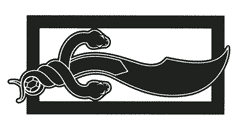
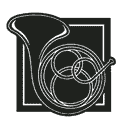
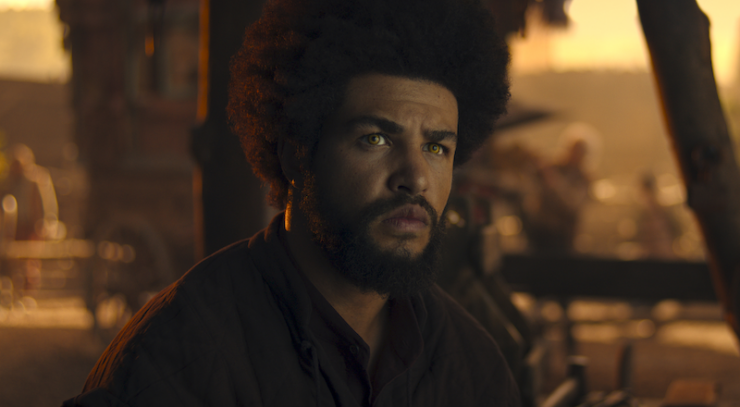
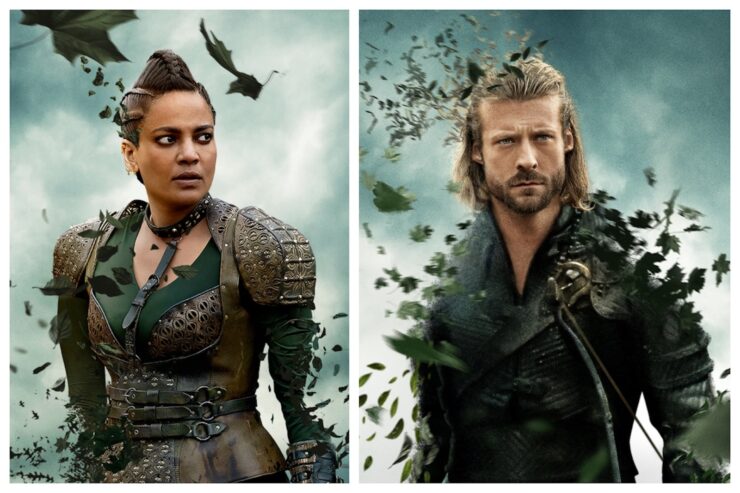
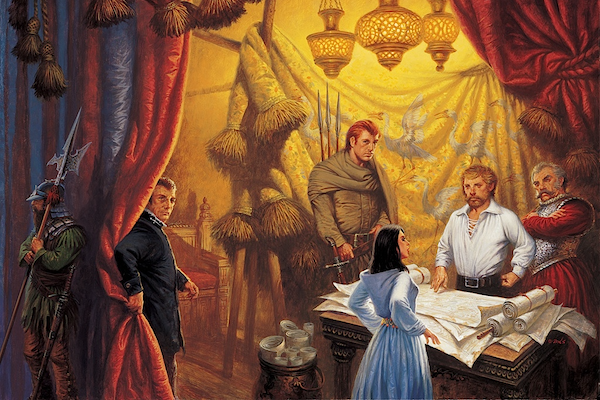
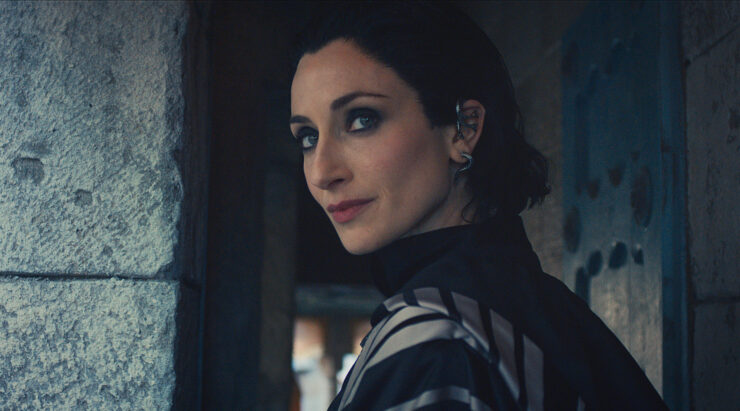
The new book cover is MUCH better!
Believe the link to the original reread post is incorrect; it should be: http://www.tor.com/2009/02/27/the-wheel-of-time-re-read-the-great-hunt-part-9/
@2 – Thanks for the heads-up! The link’s been fixed.
Leigh, re your question of a ripped out hero or born again hero meeting their Horn of Hero version, see the entry for Gaidal Cain in the Wheel of Time Companion book. IMO, it answers your question. I think the entry for at least one other hero will also answer your question (but I cannot remember which hero). I will not say anything else on this matter in case we are not providing spoilers for the Black Book.
Am I the only one to pick up on the differences between how the Heroes fought in Falme vs how they fought at the Last Battle. In Falme, there weapons are mystical/sorcery. Birgitte’s arrown in this chapter appears as a flame streaked arrow (IIRC — but I am almost positive it is not a normal arrow. It arches way to long into the harbor). Yet, when she was called back, she shot Mellar through the chest with a normal arrow (albeit a silver arrow).
Thanks for reading my musings,
AndrewHB
@@.-@ I’m going to guess that the Dark One’s influence on the pattern diminishes their supernatural abilities since they appear to be directly linked to the Pattern (and as the Pattern weakens, so do they), but that’s just a guess.
The logistics of this fight are completely ridiculous and while everything that occurs is quite awesome, this is probably the most poorly described battle across all the books. That being said, it wasn’t until this read that I realized that Nynaeve, Elayne and Egwene are running and gunning for the entirety of this fight, setting half the town ablaze until Rand defeats Ishy and the Heroes drive the Seanchan back across the Aryth Ocean. Seriously, how badass is that?! It’s another “we sort of but maybe also didn’t need rescuing” moment that gets replicated at the end of The Dragon Reborn and a few later moments throughout the series.
Also, when I first read TGH I thought this was the last we would see of the Seanchan… was so exceptionally wrong on that count.
Another thing that struck me on re-read was just how much WoT stands above other fantasy series in ambition, execution and originality. I can safely say I had no clue where this story was going and the places I thought it would end up is not at all where it heads.
It’s possible Nyneave was speaking more of cultural standards – but overall I agree with you. I think maleness/femaleness are things, for sure, but not in the way culture seems to portray them.
I love Nyneave but it just goes to show she also has her blind spots.
Verin taking the third option is pretty much one of my favorite moments in the series (rather, when the big reveal comes :) )
Ny worries about a damane feeling her ability to channel, but what about El? She isn’t walking next to a damane to obscure who can channel.
Elephants are the Seanchan creatures that Rand has the most trouble describing although they are the only real animals.
Has Mat ever tried to blow a horn before? He wasn’t good with a flute, but seems to have no problem with the Horn.
Rand says he needs to channel to fight Ishy, but then just uses the sword, and Ishy just uses his stick, too. Ishy may be more interested in talking than fighting, but Rand should distract him with the sword and than kill him with the Power.
The Whitecloaks are accidentally fighting for Rand’s side here. What would they say if they knew they are fighting for a male channeler? And most of the Seanchan would probably be unhappy if they knew they are Ishy’s army.
Re: Digital cover – Am I the only one who thinks it depicts the same scene as the original cover, only better (yet no more true to the book)?
I believe that the characters in the background are Loial and Lanfear, with Rand holding the Horn.
If this scene were depicting the Battle of Falme it’d be Mat holding the Horn, no?
Leigh – correct me if I’m wrong, but I always thought BOTH the DKS and new cover art depicted the scene where Rand, while still with “Selene” and Loial recovered the Horn of Valere from Fain, NOT the Battle of Falme…which would mean trollocs were present…
As to your question on the cover, the scene depicted is the same one depicted in the DKS cover, just from a different angle. If I recall correctly, it’s shortly after Rand, Loial, and Selenefear recover the horn from Fain.
AndrewHB @@.-@
A Hero ripped out can’t meet his or her counterpart when the Horn is called. Any Hero active as flesh and blood will not appear when the Horn is sounded. It was true for Lews Therin. It happened to Gaidal Cain as well. It could have happened to Birgitte if she hadn’t died in the nick of time.
As for Birgitte’s power… Her bow in Falme was powerful enough to sink a Seanchan greatship with one shot. I imagine if she used that on Mellar, the collateral damage may well kill Elayne as well. Which would have defeated the purpose.
I have never read this book before. It is great.
I like the ebook cover much more, partly for the misty atmosphere but mostly because the Trollocs look like Trollocs, not men with horned helmets like those on the back of the DKS cover, grrr. And we’re not looking up Rand’s nose.
Oh, another thing to note:
Does it strike everyone else as odd that Egwene is not ta’veren? Literally everything that she does or that happens around her screams “I’M TA’VEREN!” and Robert Jordan even makes a joke about it later when someone asks if she is and she replies (summarizing here) “I’m the Amyrlin and that’s quite enough for one person”. Even when Mat, Perrin and Rand are far away from her she exhibits an extremely powerful draw. I mean, hello, Siuan showing up to the rebel camp right on time to help her rise to power? Her usage of the Band of the Red Hand (yes, Mat was there, but the benefit was all hers, which is not how ta’veren influence typically works). Nynaeve, Elayne and Min showing up to rescue her right as luck swings Seanchan attention away from them? I mean, c’mon.
My only explanation would be that four ta’veren would just be pushing it. But it just goes to show how much ta’veren is ultimately just a meta way of describing plot importance. If no one in the book mentioned ta’veren ever, no reader would bat an eye at the coincidences.
Longtimelurker @9:
Um… huh. You are quite correct. Oops! Will have to fix that. Thanks for pointing it out!
Shouldn’t Nynaeve have said “Rand would never ever kill a a woman in a million years” here? Also Elayne claiming “Rand would do that” is pretty weird given that she didn’t know his personality at all at this point. Besides, as a future queen she would be expected to order the execution of plenty of people and had probably seen her mother do it quite often…
re: Birgitte’s flaming arrow
So, I guess we can conclude that Birgitte is a female Hawkeye with a quiver full of all purpose arrow heads.
@16 Bergmaniac
Rand hadn’t developed his “me no kill womenfolk”-OCD by this point. And since he never was in a position to do so before, it makes sense that Nynaeve assumes that it could go either way.
Elayne’s claim also makes sense, especially because she doesn’t really know him yet. This is still puppy love and he’s her knight in shining armor ready to save the damsel in distress, punish the wicked, vanquish evil, etc. etc.
@@@@@ Leighdb I believe you’re right in the male/female not being all that different, even science seems to come to that conclusion recently. http://news.sciencemag.org/brain-behavior/2015/11/brains-men-and-women-aren-t-really-different-study-finds
As you i think most of the differences are cultural and those differences that might be biological are probably mostly exaggerated due to cultural roles we have (had), there are plenty of differences to go around (person to person) in the human brain but the overlap between male/female is so large that personal idiosyncrasies might make the biggest impact overall.
Leigh, I think your view of feminism has much to be admired. Indeed I would hope that it’s how most feminists (male or female) would view the issue. My own take on it is that different does not mean unequal, and that we should focus our attention on individual relationships instead of getting all caught up in stereotypes. The old joke that “you’re unique, just like everyone else” is funny because it’s true. Any one man is different than another man, just as both are different than any other woman. Yes, there are some generalizations that can be made, and it’s debatable how much of the difference is biology and how much culture, but for every generalization there are a million exceptions. Better to take each person as they are, good and bad, with love and respect, than try to force people into some gender-free neutrality in the name of equality.
Randalator @17
Actually as it eventually occurred, this unwillingness to kill women is actually a common trait among Two Rivers folk. Perrin and Mat all had the same issues to varying degrees. Rand just had it worse due to stress and PTSD(and impending insanity). I agree though that Nynaeve as usual just terribly misjudged her menfolk.
On the cover:
The “Trolloc” on the DKS cover could actually be a Seanchan soldier. Judging by how the horns resemble a Seanchan helmet’s antennae-like plumes.
@20 alreadymad
No, they’re not insect-like. In Darrel K. Sweet’s world there were apparently men present who liked to dress up as Trollocs…
TGH full cover
Randalator @21
LOL. Affixing animal horns to helmets does have its basis in history and fact though.
I have to preface this by saying that as usual, Jordan (or Harriet) was good at coming up with titles with multiple meanings. For while the obvious meaning of Chapter 46’s title is Ingtar returning to the Light, it could also be metaphorically true of Egwene–not that the Seanchan are to be equated with the Shadow, but that the horror they inflicted on her was in danger of causing her to fall into a hatred and need for vengeance no better than that borne by some of the Forsaken. As Nynaeve herself says in that powerful moment Leigh originally quoted, while it’s understandable and even right that she would hate the Seanchan for what they did to her, to become just like them would truly be letting them win. The fact Egwene has to fight this tendency throughout the rest of the series is quite telling.
Of course I am no one to judge, since like Leigh I was very pleased at this turn of events, and cheering at Egwene’s response as well. But then I do have a very powerful vindictive streak… That said, I can’t recall what my initial thoughts were on the reveal about the sul’dam, other than that it made perfect sense the Seanchan would have a different place in their society for sparkers vs. learners, and that I was looking forward to what would happen when the rest of the Seanchan found out. While we never got the reaction we were hoping for from Tuon, Egeanin’s reaction rather makes me think the truth will have a far greater effect on their society at large than it did on the highest nobles (some of whom may already have known or suspected). So the change in Seanchan we were all hoping for may still be coming.
Can’t really blame Egwene for her attack either, and while it’s true sneaking would have been the better option, I’m not sure what good it would have done. The Seanchan were, presumably, lined up and waiting for the Whitecloaks, so even if they hadn’t been suspicious of the four women leaving the damane house, the brewing conflict probably would have caught the girls up in the end anyway.
Rand’s thoughts in the alley do suggest Egwene might be ta’veren after all. Of course he also feels connections to Elayne, Min, and Nynaeve (presumably; she doesn’t feel one later to him, but that doesn’t necessarily apply at this moment) and they aren’t ta’veren, so it may just be a case of all those important to him (the threads and pieces, as he thinks) influencing him, since indeed in one way or another he would have failed without them, including in having a full and complete life. Also, if the theory is correct that Egwene is Latra Posae (or filling her role), then that’s a tie to him/Lews Therin right there. Min and Elayne have one too (especially if they do have some connection to Ilyena) but that doesn’t explain Nynaeve. Hmm…
I still say Ingtar going on about how logical it was to join the Shadow shows a White was involved, which points to Alviarin since she was in Fal Dara. The only problem with this is that, unless things were shown out of chronological order, the Darkfriend Social (which Jordan confirmed Ingtar attended) happened before the Amyrlin’s party reached Fal Dara. Of course I suppose Alviarin could have been secretly in the area beforehand, and subverted him then, but…eh.
But yeah…I remember being very moved by Ingtar’s redemption and Rand’s benediction (that Borderlander blessing never stops having power no matter how many times I hear it in the series), and while I was disappointed by his betrayal, it made so much sense in retrospect. And I do believe he earned forgiveness by what he said here, and what he does. The manner of Rand’s final view of him, how he “stood as he had when Rand first saw him”, reminds me rather of Hawkin from The Dark Is Rising, and how after he finally repents and returns to the Light, his eyes were “the kind, twinkling ones of the beginning”. The parallel is apt I think, and not just because both series use Light and Dark/Shadow.
And yes, while being with the ta’veren likely did have some influence, I too like to think he made the choice on his own, because in his heart he wanted to and just needed the nudge/inspiration/example to follow.
Not going to comment though on Nynaeve’s statement, other than to agree that of course it’s hogwash, that indeed as much as many of us would like to believe (and have even been taught to since feminism’s inception), women do not have a magical superiority over men. Some Women Are Wiser, but some are not, or some women are wiser about some things while some men are wiser about others. It really all depends, and can’t be generalized.
Ingtar is pretty alone though. The closest to him (and Tomas) is Asmo, but while he didn’t convert only when the Trollocs were about to eat him (or when he was about to have his soul taken by the Dark One, possibly, as Sheriam might), the fact he threw his lot in with Rand was motivated solely by self-interest, to save himself from future punishment at the Dark One’s hands, and because he thought helping Rand win was the only way to survive in general.
Mat’s comment about thinking the Seanchan were there for him and the others is as hilarious as it is foreshadowing, considering he’ll end up both fighting and leading them later on. Even without Rand’s unvoiced thought, knowing where things go later it’s quite amusing–they aren’t just the three most powerful ta’veren ever, but Perrin will later earn Tylee’s respect as the Wolf King, and Mat of course ends up Prince of the Ravens! Nice bit of metafiction there. “Who are they”, indeed–main characters, of course.
I still remember how goggle-eyed I was when the Horn was sounded. If its discovery right at the end of the first book had me shocked, this was even more stunning. Granted it was hand-waved nicely with the loophole about the Last Battle not being the only time it had to be blown, but even so, seeing it used now was absolutely incredible. Of course the chapter title and the icon kind of gave that away, but I seem to recall upon first seeing those, I just kind of had my throat lock up in excitement, and didn’t let myself think of what could be coming. And it was so worth the wait.
I may not be as awed and amazed now as I was the first time I read it, but there are still things of interest to generate excitement or at least intrigue. For example, the still-unexplained bits about how Artur Hawkwing and Lews Therin had both fought with and against each other: presumably these were other lives that were neither in Hawkwing’s time nor the Age of Legends, so they were both other men, but if what Jordan told us was true, that Ishy and the Dark One lied and the Dragon never went to the Shadow, does that mean in other incarnations, Hawkwing did? Or just that he happened to be opposed to Lews Therin’s current incarnation? (Crazy thought: was Lews Therin Guaire Amalasan? I think this was asked and denied but I’m not sure…) And then there’s other details like why the banner was so important and how it was tied to the Heroes. While we know now that the Heroes would only come if the Light sounded the Horn, that doesn’t explain why the banner was needed (it even was needed in the Last Battle too). And of course we also don’t know all the stories and legends about the various Heroes. Still lots to ponder…
But between that, the overall awesomeness of the battle (as confusing as it was), and especially the fight with Ishy, it’s safe to say I still get that sensawunda even now.
Side notes: while we obviously don’t see anything to prove it during the Last Battle, I prefer to think Hawkwing was right, and Hurin does join their company. Birgitte laughing about Lews Therin always picking women who are trouble for him is absolutely hilarious in hindsight, considering how much trouble lies in her future with his love, Elayne! I also find it interesting that what we are later told happens to Taim and the other false Dragon, being thrown from a rearing horse, happens to Rand. The narrative implied it happened because the horses were scared by the vision from the sky over Falme, but I wonder if it wasn’t unconsciously echoing what happened to Rand?
I also had to laugh at Ishy mistakenly assuming Rand blew the Horn. I do believe that justifies a Nelson laugh. And the final blow was so satisfying. (How fitting that Sheathing the Sword got used on the two most dangerous Forsaken.) But now we have that unhealing wound to deal with…
I always thought it couldn’t be the case that there could be two Birgittes, only one could exist and be called at a time. Gaidal having been reborn and not appearing at the Last Battle clinches it, in which case it’s a good thing Birgitte died when she did. Of course if she’d stayed alive she might have been able to hold off Mellar anyway, but the way it happened was far more satisfying!
@@.-@ AndrewHB, @5 givemraptors: Not only that, but we know they are tied to TAR and actually stay there in between incarnations/summonings…and we saw in AMoL that the Dark One being close to being free plus the unraveling Pattern was causing TAR itself to come apart. So I’d imagine that would diminish the Heroes’ power too.
@5 givemeraptors: Glad I wasn’t the only one giving the Supergirls their due here!
@7 birgit: It may seem like they were just using weapons but I think more was going on there. There’s the fact Ishy seemed afraid of the sword (which he shouldn’t be of a regular weapon, certainly not to the point of literally recoiling it from like a vampire and sunlight) and there’s the nature of the unhealing wound Ishy’s staff deals. I think it is safe to say that Rand was imbuing the sword with saidin (and that’s partly why it gets destroyed), and that Ishy was using the True Power in the staff, hence why the wound wouldn’t heal and why it would later beat in counterpoint to the Mashadar wound that was anathema to the Dark One/the taint.
The Whitecloaks in general probably wouldn’t have been happy at this point, but later on their leader Galad is proud to be his brother and fight for him in the Last Battle.
@13 AeronaGreenjoy: LOL!
@17 Randalator: Awesome. I call this canon. Also good points regarding Elayne and Nynaeve.
@20 alreadymad: …which would make even less sense on the recovering-the-Horn-from-Fain scene. :P
@21 Randalator: Well, there were those Trolloc puppets from the festival in Cairhien, some of which may have been actual costumes to be worn…